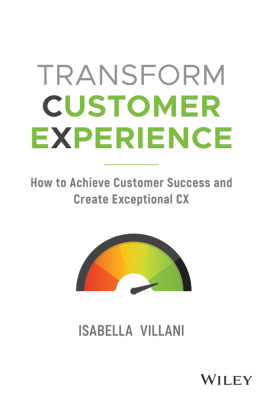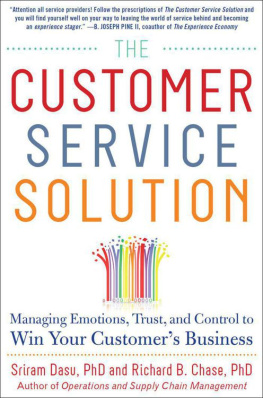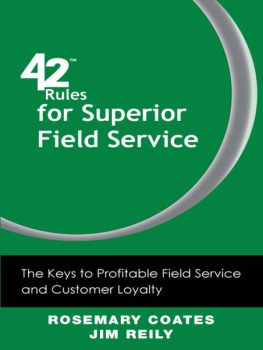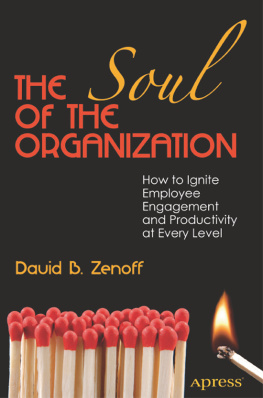The Value Profit Chain
Treat Employees Like Customers and Customers Like Employees
James L. Heskett
W. Earl Sasser, Jr.
Leonard A. Schlesinger
THE FREE PRESS
New York London Toronto Sydney

Also by Heskett, Sasser, and Schlesinger
THE SERVICE PROFIT CHAIN

Copyright 2003 by James L. Heskett, W. Earl Sasser, Jr., and Leonard A. Schlesinger
All rights reserved, including the right of reproduction in whole or in part in any form.
SIMON & S CHUSTER and colophon are trademarks of Simon & Schuster, Inc.
Manufactured in the United States of America
10 9 8 7 6 5 4 3 2 1
Library of Congress Cataloging-in-Publication Data
Heskett, James L.
The value profit chain : treat employees like customers and customers like employees / James L. Heskett, W. Earl Sasser, Jr., Leonard A. Schlesinger.
p. cm.
Includes index.
1. Customer services. 2. Consumer satisfaction. 3. Organizational effectiveness. 4. Communication in marketing. 5. Employee loyalty. I. Sasser, W. Earl. II. Schlesinger, Leonard A. III. Title.
HF5415.5 .H473 2003
658.812dc21 2002027162
eISBN-13: 978-1-439-13612-6
ISBN-13: 978-0-743-22569-4
www.SimonandSchuster.com
 Acknowledgments
AcknowledgmentsWE ARE INDEBTED to a number of people for their ideas and their patience in testing ours.
First are those practicing managers from whom we have learned important lessons. They include Colleen Barrett, Pete Blackshaw, John Bogle, William Bratton, Charles Cawley, Scott Cook, Cliff Ehrlich, Bill Hybels, Herb Kelleher, James Kinnear, Bruce Nelson, Alan ODell, William Pollard, Jamie Priestley, Frederick Reichheld, Hal Rosenbluth, Don Soderquist, Tom Watson, Mel Warriner, Jack Welch, and Lorenzo Zambrano. Gary Loveman and John Morgridge, who divide their time between the real world and the academic, have been valued sources of ideas.
On the academic side, over the years we have benefited especially from an exchange of ideas with current and former colleagues, including Jim Cash, Roger Hallowell, Luis Huete, Tom Jones, Robert Kaplan, John Kotter, Christopher Lovelock, David Maister, Robert Miles, Miguel Ochoa, and Jeffrey Rayport.
Field casework and research have yielded a number of insights in support of this work. We are particularly indebted to those who have helped us in these efforts. They include Ken Carrig, Alan Grant, Norman Klein, Lucy Lytle, Dan Maher, James Mellado, Dan OBrien, Kenneth Ray, and Jeffrey Zornitsky.
Laura Berkman Coleman served as our research associate on this effort. This involved everything from fact checking to tracking down elusive sources of information. We are indebted to her for her creative detective work.
The dean of the Harvard Business School, Kim Clark, and the Schools Division of Research provided important sources of support for our work. Bruce Nichols was very helpful in shepherding our manuscript through the various steps to publication. We also owe a special debt of gratitude to our longtime friend and editor, Bob Wallace, who as always provided encouragement as well as detailed comments and advice at critical moments in our project.
Finally, we are grateful for the understanding and forbearance of our spouses and partners, Marilyn, Connie, and Phyllis, for our work together over the years.
James L. Heskett
W. Earl Sasser, Jr.
Leonard A. Schlesinger
 Contents
Contents7. Employee Relationship Management
Treating Employees Like Customers
8. Customer Relationship Management
Treating Customers Like Employees
 Preface
PrefaceOUR RESEARCH over the past three decades has led us to conclude that winning organizations:
- Have strategies encompassing well-aligned cultures as well as market and operating foci designed to deliver results and processquality (versus products and services) to important constituencies.
- Achieve results and process quality through the following:
- adherence to promoting relationships in what we call a value profit chain, one designed to foster customer, employee, partner, and investor loyalty, trust, commitment, and ownership. reliance solely on those measurements and incentives that reflect primarily the means of achieving the strategy and, secondarily, the goals of the strategy.
- establishment of strong cultures (based on widely shared values) that foster adaptive behavior as well as the development of ideas and people.
- As a result, achieve superior brand franchises, encompassing all those things that contribute to an organizations long-termstatus as the preferred seller, buyer, employer, neighbor, or place to invest.
This work, which was inspired by scholars we cited at the time, stimulated many other researchers to test our conclusions in a variety of business settings. More than 40 examples of this effort, all based on empirical research, are reviewed in Appendix A. All but two supply evidence supporting our conclusions concerning one or more of the links in the value profit chain. We believe we can provide possible explanations for the exceptions.
Ideas embodied in the value profit chain are regularly employed today by consulting organizations large and small. One of the most comprehensive of these efforts, supported by findings from detailed analyses of a large database of experience, is even touted as a total blueprint for worldwide capital.
Our homework in support of value profit chain thinking began with the introduction of a new course, Management of Service Operations, into the Harvard Business School curriculum by Earl Sasser in 1972. This inspired other research that resulted in the publication of three books. The first of these essentially laid out the hypotheses that would later evolve into value profit chain concepts. The second examined ways in which these concepts were being applied to create what we called service breakthroughs. The last provided, through research in more than 200 large corporations, factual evidence about the kinds of strong corporate cultures that didand did notsupport outstanding long-term performance.
The work continued with the publication of a Harvard Business Review article, Putting the Service Profit Chain to Work, in 1994 and a book that expanded on the theme. The article and the book presented evidence to support a set of relationships accounting for much of the corporate profitability and growth that we had been observing throughout a collective experience of nearly 100 years of teaching, consulting, and managing. It was intended to provide a fact-based roadmap for leaders of for-profit and not-for-profit service organizations wishing to upgrade the performance of their organizations, based on a pattern of experiences observed in the very best service organizations, ranging from Southwest Airlines (from shortly after its founding to the present) to the New York Police Department (under then-commissioner William Bratton).
Our goal was to set forth an organizing framework that was simple, workable, measurable, and memorableall essential to effective implementation. The service profit chain and its related concepts served the purpose on all counts. It was so simple and intuitive that it has been labeled obvious by some of our critics, a label we regard as the ultimate compliment. In a sense, our goal was to provide a cookbook intended to demystify a number of overly complex management concepts, not unlike what Julia Child achieved in simplifying and providing wide access to the intricacies of French cooking in her writings and television programs.












